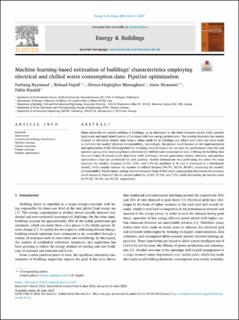Machine learning-based estimation of buildings' characteristics employing electrical and chilled water consumption data: Pipeline optimization
| dc.contributor.author | Raymand, Farhang | |
| dc.contributor.author | Najafi, Behzad | |
| dc.contributor.author | Mamaghani, Alireza Haghighat | |
| dc.contributor.author | Moazami, Amin Nitter | |
| dc.contributor.author | Rinaldi, Fabio | |
| dc.date.accessioned | 2023-07-31T11:01:22Z | |
| dc.date.available | 2023-07-31T11:01:22Z | |
| dc.date.created | 2023-07-15T09:59:36Z | |
| dc.date.issued | 2023 | |
| dc.identifier.issn | 0378-7788 | |
| dc.identifier.uri | https://hdl.handle.net/11250/3081939 | |
| dc.description.abstract | Smart meter-driven remote auditing of buildings, as an alternative to the labor-intensive on-site visits, permits large-scale and rapid identification of buildings with low energy performance. The existing literature has mainly focused on electricity meters' data from a rather small set of buildings and efforts have often not been made to facilitate the models' physical interpretability. Accordingly, the present work focuses on the implementation and optimization of ML-based pipelines for building characterization (by use type (A), performance class (B), and operation group (C)) employing hourly electrical and chilled-water consumption data. Utilizing the Building Data Genome Project II dataset (with data from 1636 buildings), feature generation, feature selection, and pipeline optimization steps are performed for each pipeline. Results demonstrate that performing the latter two steps improves the model's accuracy (5.3%, 2.9%, and 3.9% for pipelines A, B, and C compared to a benchmark model), while notably reduces the number of utilized features (94.7%, 88.3%, 89.4%), enhancing the models' interpretability. Furthermore, adding features extracted from chilled-water consumption data boosts the accuracy (with respect to baseline) for the second subset by 12.4%, 13.5%, and 7.2%, while decreasing the feature count by 97.2%, 96.4%, and 96.5%, respectively. | en_US |
| dc.language.iso | eng | en_US |
| dc.publisher | Elsevier | en_US |
| dc.rights | CC BY NC ND | * |
| dc.rights.uri | http://creativecommons.org/licenses/by-nc-nd/4.0/ | * |
| dc.subject | Smart meter; Commercial buildings classification; Machine learning; Feature extraction; Feature selection; Pipeline optimization | en_US |
| dc.title | Machine learning-based estimation of buildings' characteristics employing electrical and chilled water consumption data: Pipeline optimization | en_US |
| dc.type | Peer reviewed | en_US |
| dc.type | Journal article | en_US |
| dc.description.version | publishedVersion | en_US |
| dc.rights.holder | © 2023 The authors | en_US |
| dc.subject.nsi | VDP::Teknologi: 500 | en_US |
| dc.source.pagenumber | 23 | en_US |
| dc.source.volume | 295 | en_US |
| dc.source.journal | Energy and Buildings | en_US |
| dc.identifier.doi | 10.1016/j.enbuild.2023.113327 | |
| dc.identifier.cristin | 2162388 | |
| dc.source.articlenumber | 113327 | en_US |
| cristin.ispublished | true | |
| cristin.fulltext | original | |
| cristin.qualitycode | 2 |
Tilhørende fil(er)
Denne innførselen finnes i følgende samling(er)
-
Publikasjoner fra CRIStin - SINTEF AS [5668]
-
SINTEF Community [2223]

